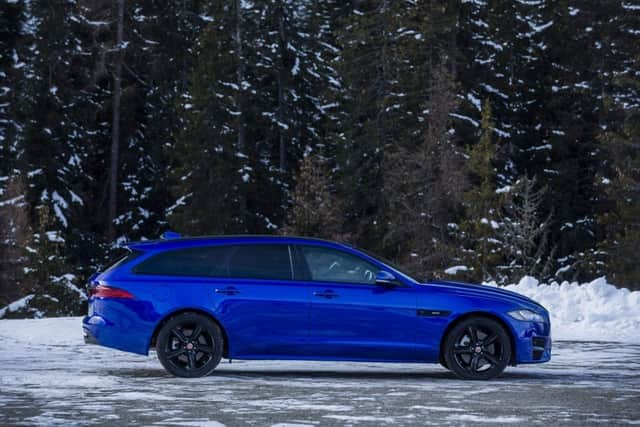Jaguar XF Sportbrake review - poise and pace in smart estate


Jaguar is making a lot of noise at the minute with its all-electric I-Pace and various conventionally-fuelled SUVs but alongside such models it continues to plug away at more traditional models, with various sizes of saloons from the compact XE to the limo XJ.
Between them sits the XF, which as well as acting as a large executive saloon also offers Jaguar’s only estate model (or Sportbrake, if you must), for those who want space without an SUV’s bulk.
Advertisement
Hide AdAdvertisement
Hide AdThere’s an aura of understated cool about the Sportbrake’s design. Its rivals from German are all about big grilles, shiny chrome and lots and lots of sharp creases but the Jag is simpler and more elegant - although the grille is hardly subtle. There aren’t too many folds or sharp edges on the run from that big grille back to the small roof spoiler atop the tailgate and the estate shape suits the Jag even more than the saloon body style.


The interior was updated at the start of 2019 and there’s an overall feeling of solidity to everything from the chunky steering wheel to the rotary gear selector and straightforward heating controls. It’s plainer than rivals and lacks the final polish of the 5 Series and A6 but as with the exterior there’s an easy simplicity to the cabin.
The Sportbrake is even more handsome than the saloon (Jaguar)
There’s also reasonable space for four adults, although a fifth squeezed into the middle won’t thank you and rear legroom isn’t the best in class. The Sportbrake’s boot is a competitive 565 litres, which is enough to swallow luggage for the aforementioned adults, if not as capacious as the massive Mercedes E-Class. It is at least broad and flat without arch intrusions, and a powered tailgate and tie-down points aid in its practicality, which is what you buy an estate for.
Jaguar XF Sportbrake R-Sport AWD


Advertisement
Hide AdAdvertisement
Hide AdPrice: £44,700 (£56,610 as tested)Engine: 2.0-litre, four-cylinder, turbo, petrolPower: 297bhpTorque: 295lb/ftTransmission: Eight-speed automaticTop speed: 155mph0-60mph: 5.7 secondsEconomy: 28.9-31mpgCO2 emissions175g/km (NEDC corr)
But you also buy a Jaguar because they’re meant to be good to drive, and the XF Sportbrake has that covered as well. It moves with more fluency and agility than a car its size and weight has a right too. It feels every bit as poised and responsive as Jaguar would have you believe and is easily a match for its major rivals. Weight distribution is a tidy 50:50 thanks to an aluminium-intensive body structure and lightweight polymer tailgate and the way it flows along a good road with plenty of feedback is a pleasure. On boring roads it reveals another side as a quiet, smooth mile-muncher.
The Jaguar XF Sportbrake's interior is comfortable but not as polished as some rivals (Jaguar)
For me, our test car’s engine was a weak spot. A 2.0-litre, four-cylinder petrol turbocharged to 297bhp, it’s got plenty of poke but thanks to its small capacity it feels as though you have to work it hard to access its performance. Nought to 60mph takes just 5.7 seconds and once the turbo is working the XF can make quick progress but, for me, I want it to feel less strained. As unfashionable as it might be to bang the diesel drum, the 297bhp V6 diesel remains a better, if markedly more expensive, choice, with a surfeit of torque always available to aid effortless progress and economy of 42mpg compared with the petrol’s 31mpg.


Advertisement
Hide AdAdvertisement
Hide AdThe XF Sportbrake's boot is on a par with most rivals (Jaguar)
In R-Sport trim, the XF costs from around £45,000 and brings the kind of equipment any buyer would expect from a premium model. Leather sports seats, self-levelling air suspension, a powered tailgate and automatic operation for lights, wipers and twin-zone climate control are standard, as is a 10-inch internet connected navigation/media system and a host of sporting styling touches. Our test car’s options added everything from a head-up display and gesture-controlled tailgate to 20-inch alloys and a panoramic glass roof.
The XF Sportbrake is competing in a relatively small but very tough pool. Is it the best in that class? Probably not. But with its excellent driving dynamics, space and understated style it’s well worthy of consideration.
The 296bhp petrol packs a punch but isn't as easygoing as the equivalent diesel (Jaguar)
This article first appeared on The Scotsman